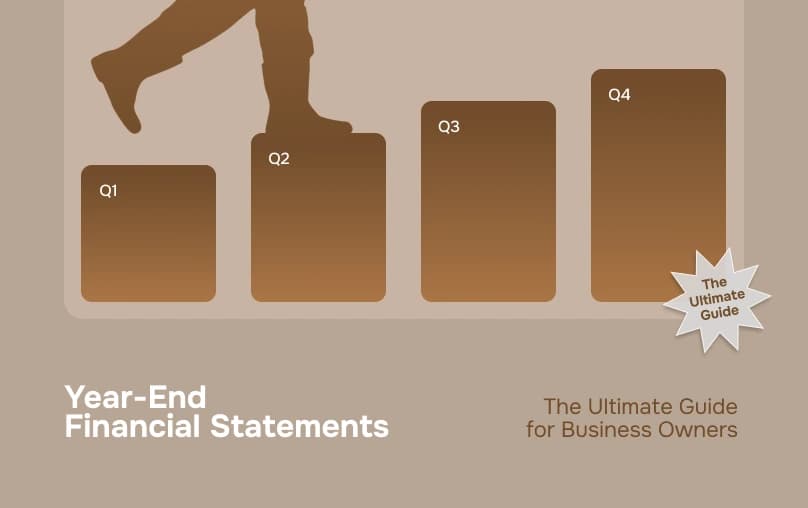
Let’s face it, when you started your business, you probably didn’t dream about spreadsheets and ledgers.
But here we are.
And whether you love numbers or avoid them like pineapple on pizza, year-end financial statements are non-negotiable if you want to run a successful, growing business.
So let’s break it all down, what these statements are, why they matter, who looks at them, how to get them done without losing your mind, and why outsourcing might just be the best gift you can give yourself this year.
What are year-end financial statements?
Year-end financial statements are a set of official records that sum up your business’s financial activity over the past year. Think of them as your business report card, except instead of math and science, you’re graded on profit, expenses, assets, and cash flow.
These typically include:
Balance Sheet
The balance sheet is like a snapshot of a company’s financial standing at the end of a reporting period. It tells you three main things:
• What the company owns (assets)
• What it owes (liabilities)
• What’s left for the owners or shareholders (equity)
It’s useful for assessing a company’s stability and financial strength immediately.
Income Statement
The income statement, AKA Profit and Loss Statement, shows how a company performed financially over a period.
It answers the simple question: Did the company make money?
It tracks all income earned and expenses incurred during that time and ends with the net profit or loss. It’s key for measuring profitability and comparing performance across different periods.
Comprehensive Income
Comprehensive income goes a step further than the income statement. While the income statement shows profits from regular business activities, comprehensive income includes other gains and losses that aren’t part of day-to-day operations.
This might include things like changes in the value of investments, currency exchange impacts, or pension adjustments. It gives a fuller, more complete picture of a company’s financial outcomes during the reporting period.
Cash Flow Statement
The cash flow statement shows how cash moved in and out of a business over a set period. It’s not about profits; it's about actual cash.
Even if a company is profitable, it still needs enough cash on hand to pay bills, invest, and operate smoothly. This statement breaks down where the cash came from (like sales or loans) and where it was spent (like paying employees or buying equipment), helping stakeholders understand if the company is managing its money wisely.
Why Bother with All This?
Well, here’s the deal: whether you like it or not, your financial statements are the backbone of your business decisions. You can’t just wing it when it comes to growth, taxes, or investors. Having clean, accurate year-end financials helps you:
• See how your business is really performing.
• Make informed decisions about budgeting, hiring, or investing.
• File taxes without scrambling.
• Show banks or investors that your business is organized and financially sound.
Long story short: if you want your business to thrive, these statements aren’t optional, they’re essential.
Who Actually Looks at These?
Besides you, a lot of people:
• Investors want to see your profits and growth.
• Lenders check your financial health before handing over money.
• Tax authorities need accurate data to calculate what you owe.
• Internal teams use them to plan for the next year.
Basically, your financial statements talk. Make sure they’re saying the right things.
How to Prepare Year-End Financial Statements (Without Losing Your Mind)
1. Gather all invoices
Reach out to your suppliers and ensure all bills are accounted for. No financial stone left unturned.
2. Make sure you’ve billed all your customers
Verify that every client has been invoiced. This keeps your income accurate and cash flow healthy.
3. Account for year-end wages
Even if wages haven’t been paid yet, ensure those amounts are recorded for the current year.
4. Audit your inventory
Keep record of everything and compare physical inventory with your records. While it might not be exciting, it’s essential.
5. Calculate depreciation
Assets lose value over time. Ensure this is reflected so your financials and taxes are accurate.
6. Reconcile bank accounts
Match internal records with bank statements, credit card statements, and vendor records. If there are discrepancies, correct them with appropriate journal entries.
7. Review drafts carefully
Don’t rush, thoroughly check every figure. Look for unusual patterns or errors.
8. Estimate and accrue taxes
Evaluate your tax obligations based on your income statement. The earlier you do this, the better.
9. Close your books
Once everything is checked and confirmed, wrap things up. Any new transactions will be part of the next fiscal year.
This process will help you quickly prepare the core statements: Income Statement, Balance Sheet, Cash Flow, and Comprehensive Income.
Want the Easy Button? Outsource It
Let’s be honest, most business owners didn’t start their company because they love spreadsheets and journal entries. And that’s okay.
You’ve got a business to run, clients to serve, a team to lead. Spending days buried in paperwork probably isn’t the best use of your time.
That’s why outsourcing your year-end financials to a trusted accounting partner is a total game-changer. They know the ins and outs of compliance, tax rules, and financial reporting, and they can save you from making costly mistakes.
It’s like calling a mechanic instead of rebuilding your own engine. Sure, you could do it, but wouldn’t you rather focus on what you do best?

Shekhar Mehrotra
Founder and Chief Executive Officer
Shekhar Mehrotra, a Chartered Accountant with over 12 years of experience, has been a leader in finance, tax, and accounting. He has advised clients across sectors like infrastructure, IT, and pharmaceuticals, providing expertise in management, direct and indirect taxes, audits, and compliance. As a 360-degree virtual CFO, Shekhar has streamlined accounting processes and managed cash flow to ensure businesses remain tax and regulatory compliant.
You might also like:
- QuickBooks vs. Xero vs. Wave: Which One Really Fits Your Business?
- Understanding Activity-Based Costing: The Smarter Way to See Your Real Costs
- Why Cloud Accounting Is the Future of Financial Management
- Why Small & Medium Businesses (SMBs) Prefer a Certified QuickBooks ProAdvisor
- Financial Accounting vs Managerial Accounting: Two Sides of the Same Coin
Listen Exclusive Podcast On

